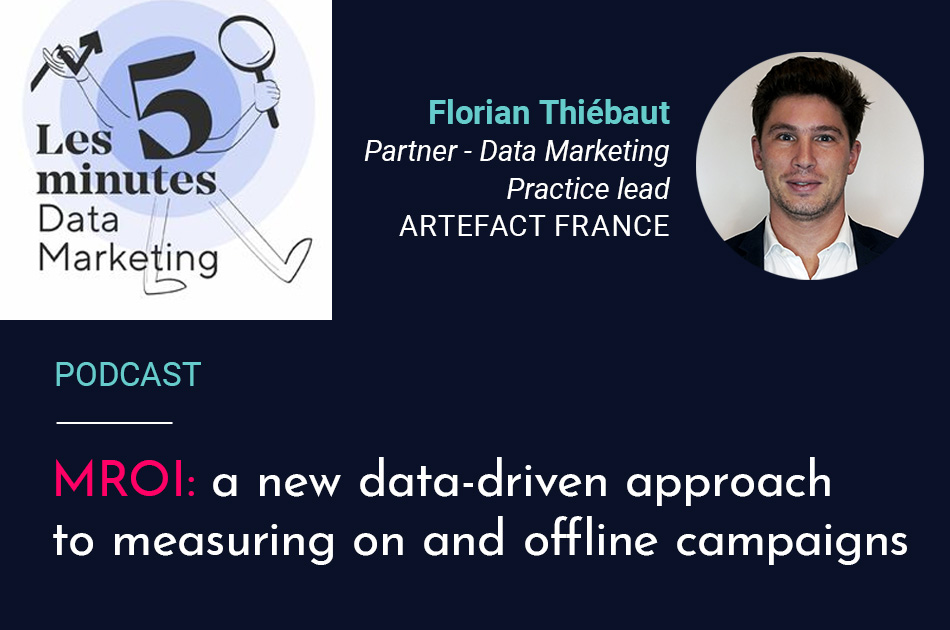Florian Thiebaut, Partner and Data-Marketing Practice lead at Artefact, spoke to the podcast “Les 5 minutes data” created by Intuiti. In this episode, Florian Thiebaut is interviewed about the innovative solutions for measuring the performance of online advertising campaigns available to Artefact clients.
Indeed, techniques such as MMM, attribution, or geographic experiments are no longer sufficient to meet the needs of advertisers in a rapidly changing context. For more granular, more frequent, and more activable insights, it is necessary to bring a new dimension to these solutions by relying on data. This new approach, called MROI at Artefact, allows advertisers to better manage their investments by answering questions such as: “How can I optimise my media mix to meet my brand awareness objective?” or “What incremental value do the new formats we are testing bring compared to traditional campaigns?”
Transforming performance measurement is essential in a changing economic, technological and legal context
Marketing performance measurement is becoming an increasingly complex topic for advertisers. Advertisers must rethink traditional methods to meet today’s challenges, under pressure from 4 factors:
1- Digital channels and formats have multiplied in recent years. Social networks are diversifying and display formats are evolving, especially those offered by Google such as Discovery campaigns, Performance Max campaigns or local campaigns on Google Maps for example.
2- The regulations related to the processing of personal data have been strengthened. The collection of consent prior to the deposit of cookies has repercussions on the measurement of campaigns since it was historically based on this type of tracer.
3- The technical environment is changing. Third-party cookies and certain personal identifiers, such as mobile IDs for example, are about to disappear. These are decisions made by web and mobile browsers, not regulations.
4- The uncertain economic context (pandemic, inflation, hyper-competition…) impacts advertisers’ budgets and the way they manage their investments.
Historical measurement tools are insufficient to manage advertising investments in this new context
Until now, digital marketing professionals have mainly used 3 types of measurement:
1- Marketing Mix Modelling, usually performed twice a year or quarterly. MMM provides insights and recommendations across all channels (including offline). However, these are not granular enough, not easily actionable, and infrequent. Moreover, these analyses are very often outsourced to third-party players or technologies.
2- Attribution, obtained for example via Google Analytics, provides good granularity (at the level of campaigns, audience, and format) and frequency (almost real-time) of insights. On the other hand, this information remains limited to the performance of online advertisements on sales and does not really make it possible to make the link between the various channels, particularly offline.
3- Geo-targeting experiments, which make it possible to test incrementality on “twins” and to understand the impact of a change in strategy on a campaign. However, this requires frequent testing and therefore requires large budgets to obtain actionable results and recommendations.
These measurement techniques are no longer sufficient: they communicate little with each other, are only partially consolidatable and therefore do not provide an exhaustive view of performance measurement. It is therefore difficult for marketers to adapt their budgets quickly and regularly on the various levers.
MROI, a new dimension for traditional measurement techniques
At Artefact, we are implementing a complementary approach to the three techniques mentioned above, which our longstanding clients have already taken advantage of. This approach, which we call MROI, consists of internalising and automating MMM analyses to go beyond frequency, granularity and actionability of insights.
To achieve this, Artefact’s MROI solution leverages the computational capabilities of cloud technologies such as GCP, data visualisation technologies such as Looker, and the highly granular cross-channel data provided by the Google GMP suite of tools.
In this way, data processing is automated to obtain insights that can be visualised dynamically via Looker. This makes it possible to help marketers answer the questions they ask themselves on a daily basis, such as
Finally, it should be borne in mind that the automatic ingestion of offline data remains a challenge. The transformation of cross-channel campaign measurement is therefore still in progress. On the other hand, these new approaches are perfectly feasible for online channels and bring a new dimension to the management of digital advertising investments.

 BLOG
BLOG






